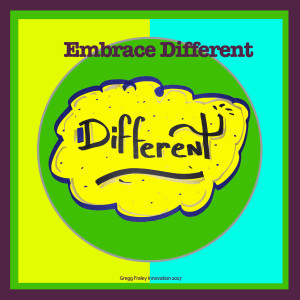 Different Isn’t That Difficult; It Requires … Doing Things Differently
Different Isn’t That Difficult; It Requires … Doing Things Differently
Innovation Programs Based On Best Practices are Doomed to Mediocrity
Things I’ve heard recently from c-suite executives about their own innovation programs:
“Floundering and ineffective, if I’m honest.”
“Mediocre results, we just can’t seem to get to anything really different.”
“Lackluster. I’m not impressed by what they come up with.”
“We don’t do idea generation well.”
These are the words I’ve heard innovation directors and c-suite executives use to describe their own innovation programs. Sad isn’t it, those words are depressing. It’s enough to contemplate bringing a swift end to the thing. The quotes above are all from larger company high level managers who already have highly defined innovation processes in place.
This post is to make a simple point about innovation. Here it is:
You won’t get different, if you don’t do different.
There is so much written about innovation, it’s actually quite difficult to keep up with the literature, there’s a new book every other day. The managers above have read a lot of that literature, taken it to heart, gotten training, and put processes in place. And they’re still not getting the results they want. One of the reasons is much of the literature isn’t really new, it’s just rehashes of things that have been stated since the 50’s. But I digress.
I’m sure “do different” is bad grammar, but I stand by the meaning. How can you expect your innovation program to thrive if:
- It’s much like every other company in your industry
- It relies on proven “best practice” tools and techniques that are up to 70 years old
- Facilitators use the same old tools time and again, boring your best thinkers to tears
- It only looks at low risk options — whether this is overtly stated or not
- It’s done by people who have been told directly that breakthrough isn’t what your organization is after
- It relies on very careful market research that worships what consumers say, but pays little attention to behavior they can’t articulate
- It doesn’t take customer empathy seriously enough, but only pays lip service to understanding customer needs and behaviors
My innovation colleague Stephen Shapiro said it well in his book Best Practices are Stupid. If you are relying on best practices, and not making an effort to go beyond them, you aren’t going to arrive at different or breakthrough ideas. Best practices are good to know, good as jumping off points, but they don’t usually provide breakthrough results.
To think differently, you need to organize ideation or strategy sessions — and the entire front end of innovation cycle — using different tools and techniques, different settings, new stimulus, new speakers, new and different everything. You need to embrace Different, and also it’s cousins, Risk and New to enliven innovation projects.
For example, instead of doing a classic brainstorm, or ideation, do a MoshPit. MoshPit is a new way to combine existing trends and technologies to get to new and different. MoshPit has not been widely adopted, yet. Right now, it’s a competitive advantage. But please, wait for concrete proof (and be mediocre.)
Instead of using SWOT use a Challenge Map.
Instead of doing Brainstorming, do Brainwriting, or better yet, a BrainWalk. Or, here’s a twist, all the above.
Are you lost? Have you not heard of these tools?
If you want different, you need to try different.
Go ahead, ask me how.


